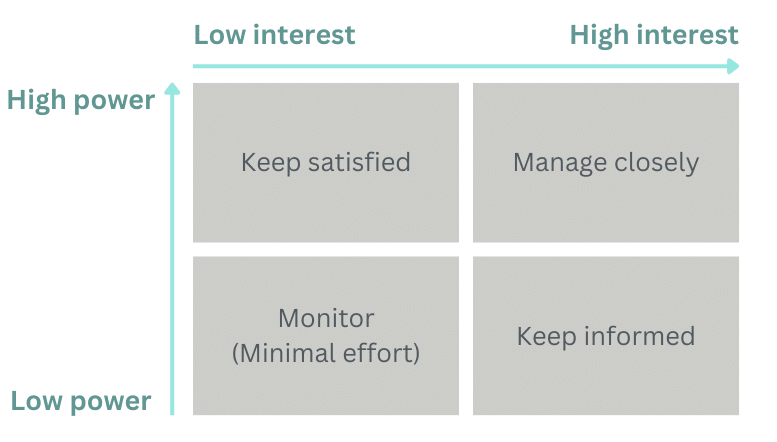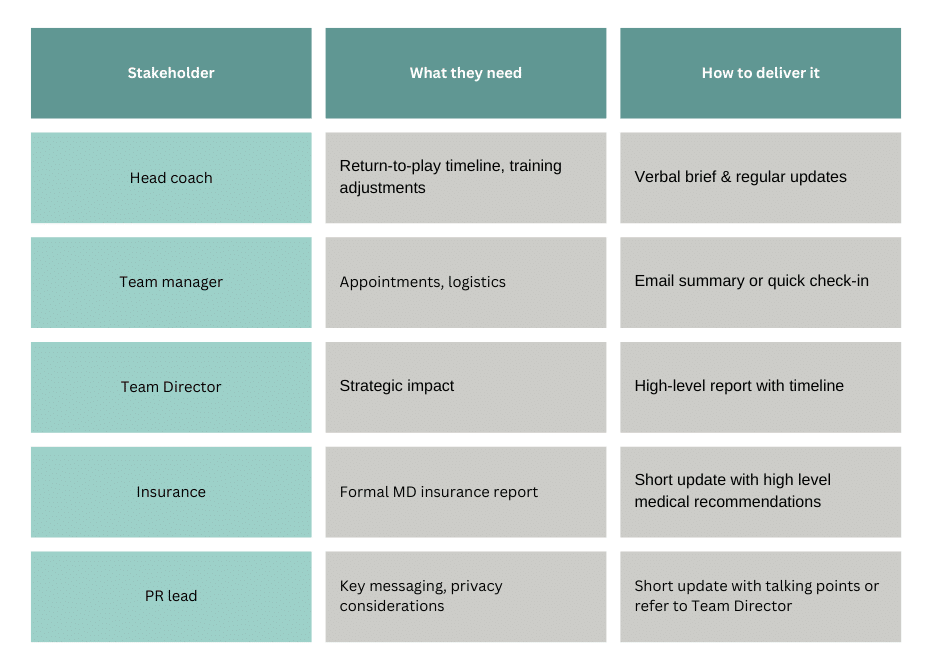Stakeholder Management in Human Performance Healthcare: Communicate with Influence, Strategy, and Empathy

In elite sport, healthcare leaders are generally confident when communicating with athletes and clinical peers. But managing communication upwards, across departments, or with external stakeholders can feel more tricky.
That’s because stakeholder management isn’t just about what you say—it’s about delivering the right information, to the right people, in the right way. Done well, it builds trust, improves department advocacy, and supports better athlete outcomes.
But when done poorly, the consequences can be serious:
- You may struggle to secure the resources, budget, or approvals your department needs
- Time-sensitive decisions can be delayed, impacting athlete care and team operations
- Senior management may lose trust in your team, resulting in reduced autonomy
- Your department’s influence and impact across the organization can diminish
- In worst-case scenarios, athlete health can be compromised due to miscommunication or lack of clarity
In short, great stakeholder communication is not optional—it’s a critical leadership skill.
-
Strategic Communication: Use the Power–Interest Matrix
Not all stakeholders have the same needs. The Power–Interest Matrix, originally developed by Mendelow (1991), is a useful tool for categorizing stakeholders based on their level of influence (power) and their level of engagement (interest). It allows you to tailor your communication so it’s targeted, efficient, and relevant.

Power Interest Matrix (Mendelow, 1991)
Here’s how this might play out in a human performance healthcare department:
- Head Coach: High power + high interest → needs regular updates and involvement in decision-making
- Team Director: High power + low interest → brief, high-level updates focused on outcomes
- Team Manager: Low power + high interest → informed when relevant, but not overwhelmed with detail
- Medical Specialist: High interest + high power → need clear, detailed medical information and relevant context for decision-making
The Power–Interest Matrix helps you spend your communication energy where it will have the most impact.
-
One Injury, Many Conversations
Imagine an athlete suffers a significant injury and will be out for several weeks. This single event may affect multiple stakeholders—but each one requires a different type of information delivered in a different way.

Same injury, different conversations. Strategic communication ensures clarity, reduces confusion, and keeps the team aligned.
-
Adapt to Individual Communication Styles
Stakeholder management isn’t just about job titles—it’s also about personal preferences and communication styles. You might have two people in the same role, but they’ll want completely different things from you.
For example, in your own experience:
- One supervisor may want detailed clinical insight, including how the athlete is coping emotionally.
- Another may prefer a high-level overview—the timeline, the impact on the remaining team, and key decisions.
As a leader, it’s your job to observe and adapt:
- If someone nods along, zones out, or rushes through updates, you’re likely giving too much detail.
- If they ask frequent follow-up questions, they likely prefer more context and depth.
- Watch how they write emails, give feedback, or conduct meetings—this tells you a lot about their communication preferences.
And sometimes, the best approach is simply to ask:
“How would you like to be kept in the loop on this?”
Strategic communication means flexing your style to match your stakeholder. That’s not just good communication—it’s good leadership.
Conclusion: Leadership Is Communication
Stakeholder management is one of the most under appreciated leadership skills in human performance healthcare. It is not something health professionals are generally taught.
Take the time to:
- Map your stakeholders using tools like the Power–Interest Matrix
- Tailor information to their role, needs, and personality
- Deliver updates clearly, in the right format and frequency
By taking these steps, you will build a reputation as a trusted communicator—someone who translates complexity into clarity, builds alignment across departments, and strengthens the outcomes for both your team and your athletes.
Great leadership isn’t about knowing more. It’s about knowing how to make your knowledge matter.
Stakeholder Management is one of the ten pillars for success in human performance healthcare teams.
>Explore the other pillars here
Are you an effective human performance healthcare leader?
>Complete this 2 minute scorecard to determine your strengths and growth opportunities.
References:
Mendelow, A. L. (1991). Environmental Scanning: The Impact of the Stakeholder Concept. Proceedings of the Second International Conference on Information Systems, Cambridge, MA.
University of Kansas. (n.d.). Identifying and Analyzing Stakeholders and Their Interests. Community Tool Box.
